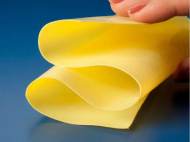Less brittle aerogels increase the usability of the lightest solid material
 Ever since we published the article about the lightest microlatice structure last year, I wanted to cover another interesting and light material which was created back in 1930s, and perfected in last 30 years. Aerogels (also known as solid smoke) are currently the world’s lightest solid material with astonishing insulating properties that could find their use into refrigerators with thinner walls that hold more food, building insulation, clothing, and other products.
Ever since we published the article about the lightest microlatice structure last year, I wanted to cover another interesting and light material which was created back in 1930s, and perfected in last 30 years. Aerogels (also known as solid smoke) are currently the world’s lightest solid material with astonishing insulating properties that could find their use into refrigerators with thinner walls that hold more food, building insulation, clothing, and other products.
Based on material used for their creation, there are several kinds of aerogels. One of them is made from silica (a cheap and abundant material found in beach sand) but those aerogels are brittle, and break and crumble easily. Researchers at the NASA Glenn Research Center in Cleveland, Ohio, managed to improve the strength of this amazing material.
They came up with two methods to produce less brittle materials. The first approach involves use of a polymer to reinforce the networks of silica that extend throughout the material’s structure, in a way similar to use of carbon fibers in building materials reinforcing. The second approach involved making aerogels from polyimide – a plastic-like material which is incredibly strong and heat-resistant polymer – and then inserting brace-like cross-links to add further strength to the structure.
“The new aerogels are up to 500 times stronger than their silica counterparts”, said Mary Ann B. Meador, Senior Research Scientist at NASA Glenn Research Center. “A thick piece actually can support the weight of a car. And they can be produced in a thin form, a film so flexible that a wide variety of commercial and industrial uses are possible.”
According to Meador, who presented the research at the 244th National Meeting & Exposition of the American Chemical Society, the new aerogel is 5 to 10 times more efficient than existing insulation, providing same insulating properties as a 12 times thicker fiberglass material.
That makes it ideal for various applications in thin-but-high-efficiency insulation for buildings, pipes, water heater tanks and other devices. Home refrigerator and freezer walls insulated with other forms of the material would further shrink in thickness, thus increasing storage capacity.
A flexible version of these aerogels could be used in a new generation of enduring and super-insulating clothing that keeps people warm in the cold with less bulk than traditional “thermal” garments. Tents and sleeping bags would have the same advantages.
Despite the fact the material isn’t suitable for firefighting clothing products, which require protection beyond the 300°C (575°F) limits of the aerogel, it could be used to insulate spacesuits and for another important space technology. NASA envisions the material could be used in an advanced re-entry system which serves as a shield for space vehicles when they re-enter the Earth’s atmosphere.
Currently used shields which protect against re-entry frictional heating are bulky and heavy, and researchers at NASA are exploring use of a heat shield made from flexible aerogel that inflates like a balloon when spacecraft enters the atmosphere.
For more information about aerogels, you can read the following paper: “Improvements to the Synthesis of Polyimide Aerogels” [5.9MB PDF].
For more information about the reinforcing process, you can read the following paper: “Process for preparing polymer reinforced silica aerogels” [439KB PDF].









Leave your response!